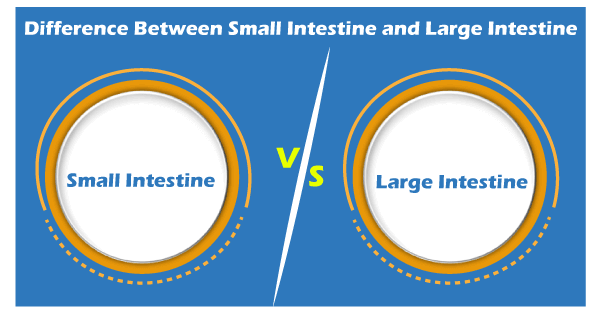Difference between Small Intestine and Large IntestineBiology has varied concepts that talk about various parts of the human body like the respiratory system, intestines, immune system, nervous system, etc. All these systems combine and form the human body. The human body is a web of systems that work simultaneously with one another in order to keep the body going. If any of these systems do not work properly, the entire body can be hampered or collapsed. With the progressing time, people are becoming aware of keeping the body healthy either through yoga, meditation, or any other physical exercises. The body is healthy if we take care of it. So today, we will be discussing about one of the major parts of the body that helps it in growing and being healthy, i.e., the large and small intestine. Let us briefly discuss their primary meanings. 
Small IntestineThe small intestine is defined as a tube-like structure that is responsible for connecting the large intestine and the stomach. The small intestine is of 20 feet in length which is folded in the abdomen. The small intestine is categorized into three parts, namely ileum, duodenum, and jejunum. All these three parts are responsible for good digestion. Digestion is carried out by the small intestine. One of the major functions of this part is that it absorbs the nutrients from the stomach into the bloodstream. The small intestine secretes enzymes, and the remaining digestion is done by the liver and pancreas. Digestion of proteins, lipids, and carbohydrates is undertaken by the small intestine. In order to keep the small intestine healthy, there are several steps that must be taken by an individual. These steps are:
Large IntestineThe large intestine is the last part of the gastrointestinal tube. It is also called the colon and is responsible for absorbing water into the system. Apart from that, it is also responsible for storing the waste material before defecation. The large intestine performs four significant functions. They are:
The primary purpose of the large intestine is to absorb salt and water from the food that has not been digested by the small intestine. The large intestine is divided into five significant parts, namely cecum, sigmoid colon, ascending colon, descending colon, and transverse colon. The food stays for around 2-5 hours in the large intestine for the absorption and digestion process. Now, let us look at some of the major contrasting points between them.
So, these are some of the differences between the small and large intestine. It is interesting to note that both of these parts carry out the function of digestion and absorption in the body. Now, let us look at some of the major functions of the small and large intestine. Functions of the Small Intestine
Functions of the Large Intestine
So, these are some major functions performed by the small and large intestines. Both small and large intestines are necessary for keeping the system aligned. Digestion and absorption take place in these intestines. Thus, the small intestine, as well as the large intestine, is one of the essential parts of the human body.
Next TopicDifferences List
|
 For Videos Join Our Youtube Channel: Join Now
For Videos Join Our Youtube Channel: Join Now
Feedback
- Send your Feedback to [email protected]
Help Others, Please Share










